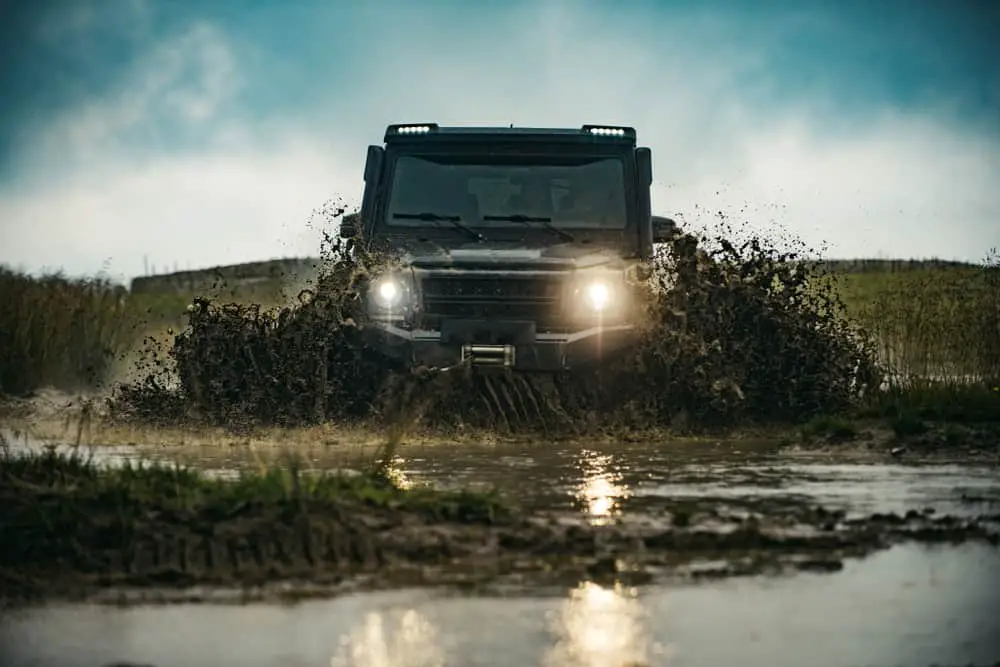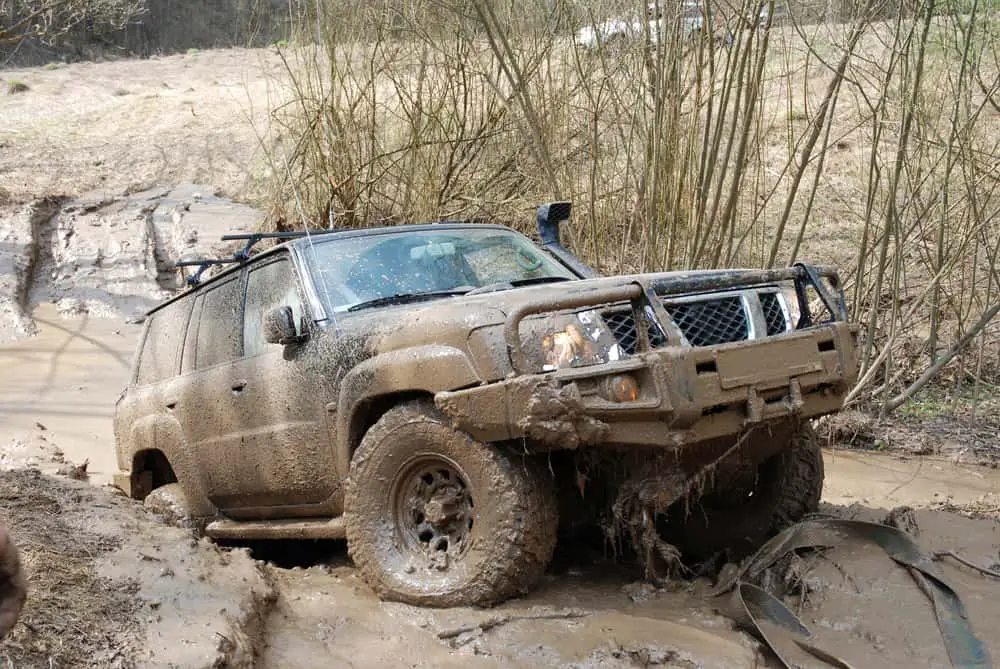
Mudding with your 4×4 vehicle can be one of the most exciting ways to enjoy the capabilities of your vehicle. Whether you are driving a manual or automatic transmission, driving in mud requires a different set of skills to sand, rock, snow, or highway driving.
Mudding with a stick shift (manual transmission) is possible. It requires some more skill from the driver to select the correct gear and to maintain momentum. Automatic transmissions always keep the vehicle in the correct gear for optimal power and torque to fuel efficiency ratio.
Modern automatic transmissions are almost the same as manual transmissions, but with some advanced options. Automatic transmissions are a more comfortable and convenient choice for on and off-road terrains. Advanced drivers often prefer manual transmissions due to lower costs and simplicity. There is, however, some additional skill required for mudding with a manual transmission 4×4. Let’s look at some of these and the pros and cons of Manual Vs. Auto transmissions.
The Basics of 4×4 Mudding
The greatest risk of mudding is getting stuck, losing traction, and being unable to move the vehicle out of the mud trap. The consistency of the mud can vary and may also hide sharp objects that could damage the tires. Like driving on sand or snow, the tires’ contact with the surface provides traction. The 4×4 mantra of “as slow as possible and as fast as necessary” applies equally to mudding as it does to other terrains.
Let’s look at some of the basic rules for 4×4 adventures and hone in on the skills required when a vehicle with a manual transmission is used:
1. Always go Mudding with others
Be prepared for getting stuck in the mud, and make sure that other vehicles present can help pull your vehicle out when stuck. Ensure that you have a kinetic rope and other recovery gear if you need to be towed out or help someone else. Vehicles with manual transmissions require additional driver skills. Even skilled drivers can get stuck. Ensure that help is at hand.
2. Lower Tire Pressure for More Traction
Lowering the tire pressure will increase the tire’s contact footprint and allow the sidewalls of the tire to be more flexible. The tire pressure should not be so low that the risk of the tire coming of the rim is increased, not below 15 psi. Whether in a vehicle equipped with a manual or auto transmission, tire deflation is always recommended when going off hard track.
3. Engage 4×4 Low Range Before Entering a Muddy Obstacle
Get the vehicle set up correctly before entering a muddy obstacle. In a vehicle with an automatic transmission this implies switching the Traction Control Off and engaging the Low Range 4×4 mode. In a vehicle with a manual transmission, the setup requires engaging the gearbox in Low Range 4×4 and locking the wheel hubs. If the vehicle is fitted with a differential lock, it must also be engaged.
Driving in Low Range 4×4 will result in the engine revolutions being higher than normal. The skill is to keep up the vehicle momentum while maintaining traction in the mud. In a manual transmission 4×4 the risk is losing momentum and causing the engine to labor at low revolutions, causing the engine to stall. Conversely if the engine is revved too high, leading to wheel spin, this may lead to the tires digging into the mud and getting the vehicle stuck.
An automatic transmission is more forgiving and requires less skill from the driver as the driver does not have to worry about gear selection and gear changes.
4. Recon the Mud Obstacle and Select a Line
Stop and get out and conduct a thorough survey of the mud obstacle before just driving into it. Study how others are doing it or if you are going to be the first to attempt the obstacle, do a survey. Use a stick to gauge how deep the mud is, and the consistency of the mud. Identify visible obstacles and plan a path that is as straight as possible. Turning the front wheels in mud can lead to a loss of momentum and cause dragging of the wheels.
5. Straight and Steady
Once you have decided on the best line to drive through the mud, build enough engine speed to maintain the vehicle’s momentum. Do not hesitate and back off the accelerator. Keep the engine speed up and maintain forward motion. Some wheel-spin is required to clean the tires without letting them over-spin and dig in. This skill is hard is earned. It will require experience and some trial and error. A mechanical gearbox gives you more to consider and control whereas an automatic box will do some thinking for you and be more forgiving.
Failure is not going to damage your vehicle or endanger your life. You will get dirty to pay for your experience. That is what mudding is all about.
6. Don’t Steer Into Deep Muddy Ruts
Select your route such that you avoid the deep ruts caused by other vehicles. These ruts can be deep and filled with soft mud. The ruts can also rob your vehicle of forward, straight line momentum when the front tires fall into them. Select a route that will give you the best chance of avoiding ruts, rocks, or tree stumps. A tire can slip off the rim if it meets a hard object at an angle under low inflation. Tire pressures should not be below 15psi.
7. Only Use the Gas Pedal, Avoid the Brake
The vehicle does not need to brake when in mud. The mud will supply sufficient resistance to the tire forward motion. Only use the gas pedal when in the mud. Vary the amount of throttle, carefully backing off a bit when the tires spin excessively, and the spinning tires slow down the forward motion. The four tires of the vehicle must work in unison to pull the vehicle through the mud. Do not decelerate until your vehicle has exited from the mud. The risk for manual and automatic transmission-driven vehicles is when the driver applies the brakes in the mud.
8. Always Know Where Your Wheels Are Pointed
Keep the steering wheel firmly in both hands when entering the mud obstacle, and do not turn the front tires. Even a slight turn of the front wheels can force the tires to turn sideways to the direction of travel and plow through the mud, potentially causing severe damage if the front wheels meet more solid resistance again.
9. Let the Front Tires Grip
If the vehicle starts losing momentum on its straight path in the mud, move the steering slightly from side to side so that the edges of the tires can find some more traction and recover forward momentum. The secret is to keep up momentum and tire traction. Guard against oversteering in this side-to-side method, keeping both hands firmly on the steering wheel in the 10 to 2 position with your thumbs facing out of the steering wheel. If your front tires hit a hard obstacle under the mud, it may cause the steering wheel to spin in your hands, and you can risk breaking a thumb.
10. Realize When You Are Stuck
If you lose momentum and wheel-spin does not clear the treads and sawing your tires back and forth does not work, and you are only going down instead of forward, stop while you are ahead and prepare for a recovery situation. If you continue to spin the tires with no forward motion, you are just digging your vehicle into the mud and making the recovery more difficult than it needs to be. Forget getting your pride hurt, and everybody gets stuck in the beginning.
11. Deep Clean Your 4×4
The fine silt in mud can cause a lot of damage to the driveline and bearings of your vehicle. Carry enough water to clean the brake discs and steering components. Get to the closest car wash and thoroughly clean the underbody, tires, hubs, steering shafts, and radiator. Mud gets in everywhere and can often be very corrosive. Do not let the mud cake and harden on your vehicle, as this can cause poor fuel consumption due to increased weight and engine overheating if the mud impairs the engine cooling.
12. Automotive Fluids are Hygroscopic, Replace them!
Brake line fluid, differential oil and diesel are hygroscopic meaning that they attract water. Contaminated fluids can no longer perform their intended function properly. Diesel can bio-degrade and cause fuel system blockages which will lead to expensive repairs. Brake fluid will lose its efficacy in distributing force and will cause the brakes to feel spongy. Repack your wheel bearings with good quality grease and make sure all seals are still good.

The Pros and Cons of Manual Vs Automatic Vehicles
| Transmission | Pros | Cons |
| Manual | * The vehicle is more engaging for the driver. * The driver has full control over gears and when to shift. * It’s usually less expensive than an automatic vehicle. * The transmission often costs less to repair. | * A manual can get tiresome in heavy traffic. * The learning curve is steep. * It requires precise control on hills to avoid stalling or rolling back. |
| Automatic | * It’s easier to drive in stop-and-go traffic. * The transmission shifts are quicker and smoother. * It offers better gas mileage. | * It’s more expensive to buy than a manual. * The transmission has more moving parts, which leads to greater repair costs. * It’s not as fun to drive, though this is subjective. * A transmission with too many gears might shift too often. |
The pros and cons comparison indicates that manual transmissions vehicles are favored by drivers that enjoy a more engaging drive where they have to apply their experience and skill to control the vehicle’s performance. Automatic transmission vehicles are favored by drivers that are looking for ease of driving and comfort. The vehicle technology must assist them in making decisions to control the traction and control of the vehicle.
The Manual Vs. Automatic 4×4 debate is a lively one that has been topical since 4×4 adventure driving became popular. The trend is the automotive industry is moving away from manual transmissions. The number of models fitted with manual transmissions is getting lower every year. Only about 1.2% of vehicles sold in the USA in 2020 are fitted with manual transmissions.
The new trend is to offer automated manual select transmissions that allow the driver to select full automatic shift mode or manual shift mode, which is especially popular in sport-utility and off-road vehicle segments.
Conclusion
After World War II, surplus army Jeeps became available for sale to the public, fueling the 4×4 craze. The Jeeps were all fitted with manual transmissions due to the rugged simplicity and lower cost. As the popularity of off-roading increased and allowed Americans to explore the roads less traveled, many models offering 4×4 transmissions grew. This growth coincided with the popularity of automatic transmissions.
The old-timers were in love with their manual transmission vehicles. Early enthusiasts became experts in the 4×4 community. Different terrains for 4×4 adventuring required some core skills common to all types of surfaces and some specialized skills. Mudding with a manual transmission 4×4 is fun but requires some specialized skills.
The Jeeps used during WWII were designed to operate in the deserts of North Africa, the jungles of the Pacific, and the muddy fields of Europe. The Jeep Wrangler remains one of the most popular off-road adventure vehicles in the world. Many off-road adventure clubs are offering interested people the training required to fully utilize the capabilities of their sport utility or off-road vehicles. Driving in muddy conditions and getting unstuck are skills that will be practiced during training.
The lower cost of an older model manual 4×4 to use as your adventure vehicle is a wise choice. You will be able to practice the proper use of your 4×4 without the fear of damaging it. Modern off-road vehicles can be expensive, and the fear of damaging your brand new vehicle might prevent you from experiencing the fun of exploring the roads less traveled.
Sources
- https://4wheeldriveguide.com/learn-pro-tips-mudding-with-manual-vs-automatic-which-is-best-in-mud/
- https://www.motortrend.com/how-to/129-0906-driving-truck-in-mud-tips/
- https://www.edmunds.com/fuel-economy/five-myths-about-stick-shifts.html
- https://www.autodeal.com.ph/articles/car-features/here-are-different-types-automatic-transmissions


